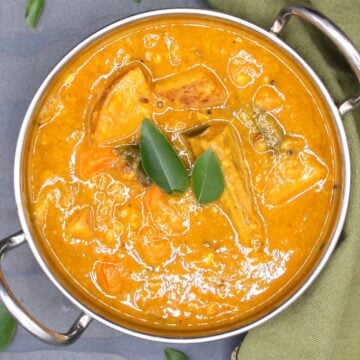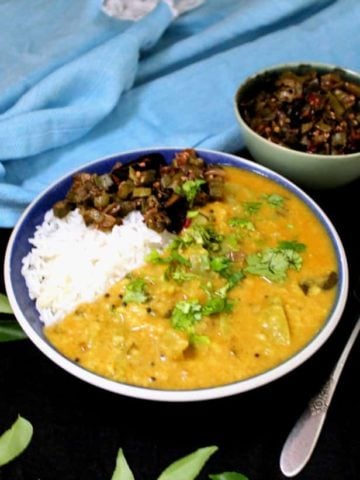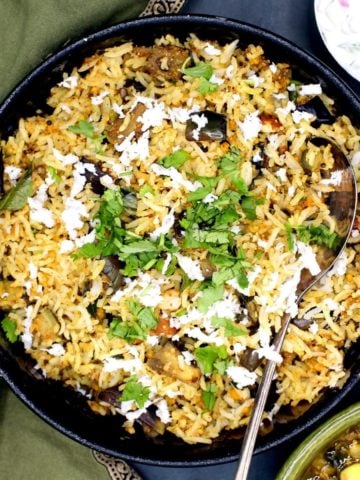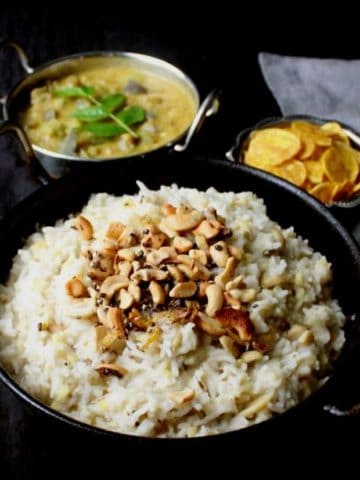Sambar is a south Indian stew of lentils and vegetables. My authentic sambar recipe has been perfected over years of making this delicious dish with the best tips from my Tamil family.

Table of Contents
What is sambar?
Sambar (also called kuzhambu) is a dal or stew made with lentils and vegetables. This is a bedrock dish of south Indian cuisine, eaten every day in homes, especially in the state of Tamil Nadu.
If you've been to a south Indian restaurant, you're likely already familiar with sambar: it's one of the dipping sauces served with dosa or idli, alongside a coconut chutney. The restaurant version is usually watered down and often too spicy: rarely on a par with a fresh, homemade sambar.
My husband, Desi, grew up eating sambar every day in his Tamil home and his mom and sisters make some of the best sambar I've ever eaten. Needless to say, when I began to learn how to make sambar decades ago, I had a very high bar to meet.
I learned how to make a good sambar - one that met my Tamil relatives' approval - quickly enough. But over the years I've honed that recipe further with tips and tricks gleaned during visits to Chennai. I can confidently claim that this sambar recipe, which I'm sharing today, is one you'll be proud to serve your family and friends. It always gets rave reviews from Desi.
Making this stew involves three straightforward steps:
- Cooking the dal or lentils.
- Roasting and blending spices into a paste.
- Cooking the vegetables by themselves at first and then with the cooked dal and spice paste.
I'll also share with you a quicker version made with shelf-stable sambar powder.
What does sambar taste like? Is it spicy?
Sambar tastes like a complex, aromatic dal with a rich interplay of complimentary flavor notes. Lentils in the masala add nuttiness, spices add depth and warmth, curry leaves add fresh, citrusy flavor, tamarind adds tang, jaggery adds sweetness and methi seeds add a soupçon of bitterness to balance out the flavors.
Most spices in sambar masala are not hot and how spicy or hot your dish is will depend on how many chili peppers you add to the masala paste. My recipe is not spicy because I use just two to three dried red chili peppers for eight servings. If you are more sensitive to heat, cut down to one or even half a chili pepper. If you are spicier, add more chili peppers - I've seen some cooks add 10 or even more.
Best lentils to use
Use toor dal (also called tuvar dal/arhar dal/thuvaram paruppu/split pigeon peas) and combine it with a little moong dal for the best flavor and a creamy texture.
Would you like to save this recipe?
Types of vegetables for sambar
You can use a variety of vegetables in this dish, the most popular being small Indian eggplants, okra, drumsticks (moringa pods), pumpkin, small shallots, potatoes, sweet potatoes and carrots. You can use a mix of vegetables, like I do in this recipe, or just one kind of veggie (for dishes like onion sambar or white pumpkin sambar).

Recipe card

Sambar Recipe
Ingredients
- ½ cup toor dal (split pigeon peas)
- ¼ cup moong dal (optional)
- ½ teaspoon turmeric
- 1 teaspoon oil (Use any oil of your choice. I used avocado oil).
- 1 sprig curry leaves
- 1 medium red onion (diced. You can also use a large shallot or 10-12 red pearl onions).
- Salt to taste
- 2 medium carrots (cut in a ½-inch dice)
- 10-12 pieces drumsticks (Moringa seed pods. If using frozen, no need to thaw first. If you have access to fresh drumsticks, use 2 drumsticks, trim the ends and cut into 2-inch pieces).
- 2 cups pumpkin (cut in a ½-inch dice)
- 2 medium potatoes (red potatoes or yellow potatoes, cut in ½-inch dice)
- 1 tablespoon tamarind concentrate (or 1 small-lemon-sized ball of tamarind, soaked in ½ cup warm water for 30 minutes. Squish the tamarind pods with your fingers to release the pulp, strain out the tamarind pulp and water, and reserve. You can discard the tamarind pods).
- 1 teaspoon sambar powder (optional)
- 1 teaspoon jaggery (or unrefined sugar)
For fresh-ground masala
- 1 teaspoon oil
- 1 teaspoon cumin seeds
- 3 tablespoons coriander seeds
- 2-3 dried red chili peppers
- 1 tablespoon chana dal
- ½ teaspoon fenugreek seeds or methi seeds (methi)
- 2 teaspoons rice (uncooked)
- ½ teaspoon black peppercorns
- 1 small red onion (or 1 shallot, sliced. If using red pearl onions, use 10-12 pearl onions, whole).
- 2 sprigs fresh curry leaves
- 1 medium tomato (diced)
For tempering (tadka)
- 1 teaspoon oil
- 1 teaspoon mustard seeds
- 1 teaspoon cumin seeds
- ½ teaspoon asafetida or hing (asafetida)
- 2 sprigs curry leaves
Instructions
Cook the dal
- Place the lentils in a pressure cooker, Instant Pot liner or saucepan. Wash in a couple of changes of water.

- Add enough water to cover the lentils by at least two inches. Stir in the turmeric.

- Pressure cook the lentils for three whistles in a traditional pressure cooker or for 15 minutes in the Instant Pot on high pressure. If cooking the lentils on the stovetop, cook 30-45 minutes or until the lentils are very soft and mushy. Mash the lentils with a wooden spoon or ladle.

Make the fresh-ground sambar masala
- Heat a teaspoon of oil in a skillet. Add coriander seeds, chana dal, dried red chili peppers, black peppercorns, fenugreek seeds and uncooked rice.

- Fry over medium heat until the coriander seeds and chana dal are a couple of shades darker and very aromatic. Remove the spices to a bowl or plate and set them aside to cool.

- In the same skillet add sliced onions and a curry leaves. Fry until the onions are soft and beginning to brown. remove them to the bowl or plate with the other spices to cool.

- Place all the ground masala ingredients in a blender along with the diced tomato. Add a cup of water.

- Blend into a very smooth paste and set aside.

Make sambar
- Heat a teaspoon of oil in a large pot or Dutch oven. Add the diced onions and a third of the curry leaves and saute until the onions are soft, about 2-3 minutes.

- Add the vegetables to the pot: drumsticks, carrots, pumpkin and potatoes. Add a cup of water to the pot, cover and let the vegetables cook 10-15 minutes or until the potatoes are tender. Stir in a tablespoon of tamarind paste or all of the pulp and juice extracted from the tamarind pods and continue cooking five minutes (don't cover the pot this time).

- Add the cooked dal and the fresh-ground masala to the pot. Mix well and add salt to taste.

- Stir in the optional sambar powder followed by the jaggery.

- Bring the sambar to a boil and continue to cook for five more minutes. Add a cup of water or more if the sambar is too thick. The right consistency for a sambar is not too thick but not too thin either. The vegetables should sink slightly below the surface, not rise to the top.

Make tempering
- In a skillet, heat a teaspoon of oil. Add mustard seeds to the skillet and wait for them to sputter. Add the cumin seeds, hing and curry leaves and fry for a minute.

- Pour the tempering into the sambar and mix it in. Turn off heat. Check salt and add more if needed. Enjoy the sambar hot.

Notes
- Cook the lentils to a mushy and soft consistency. The lentils should not hold their shape in the sambar. They should create a smooth, creamy base for the vegetables, which will add lots of texture.
- Use lots of curry leaves. Curry leaves add wonderful flavor to sambar. I use it at three different stages in this recipe.
- Use the stock from the dal. In my pressure cooker the lentils appear to use up most of the water, but if you have more liquid left in the lentils after they have cooked to the right consistency, don't throw it out. It is full of flavor. Add it to the sambar with the dal and just use less water.
Nutrition Information
To print recipe card without images, uncheck "instruction images" after clicking the "print recipe" button.
Make sambar with sambar powder
Instead of the freshly blended masala paste, add two heaping tablespoons of sambar powder to the pot after mixing in the dal. Also add a diced tomato to the pot. Taste and add more sambar powder if needed. Proceed according to the rest of the recipe.
Frequently asked questions
You can make sambar with toor dal alone, but adding moong dal helps thicken it, making it creamier. Adding two dals also improves the flavor.
Adding a little sambar powder further enhances the flavor of the sambar made with fresh-ground masala, but you can leave it out.
Drumsticks in Indian cuisine refer to the long seed pods of the moringa tree. They are 100 percent plant-based and have nothing to do with chicken drumsticks.
You can find all ingredients needed to make a sambar at an Indian grocery store, or online. I will leave affiliate links to the ingredients in the recipe box, but you will get better prices at the Indian store.
Eat it with basmati rice or with south Indian breads like idli, rava idli, dosa, quinoa dosa, jowar dosa, brown rice dosa or adai.
Store sambar in an airtight container in the fridge for up to four days.
Freeze up to three months in a freezer-safe container. Reheat in a saucepan or in the microwave until heated through. Sambar tastes best hot or warm.

























Nisha says
I should have left this comment a long time ago. I've been making this sambar recipe for nearly six months now. I've also been making the sambar powder. It's been lifechanging, truly. I make sambar with whatever veggies I have around and it is always a hands-down winner. Thank you for making our family dinners more delicious!
Vaishali says
Hi Nisha, I am so happy to hear that. So glad you and your family have enjoyed this sambar recipe.
Laki says
Hi Vaishali
Love this recipe and many thanks more in your blog. Its really great to have access to so many vegetarian creations. Thank you very much. Take care. Laki
Vaishali says
Hi Laki, so happy to hear! Thanks for letting me know.
Jigna says
This sambar was so tasty. I have made it before with a south Indian friend's recipe but this beats it. I didn't have the vegetable drumsticks but I used the small Indian brinjal instead. So yum.
Vaishali says
Hi Jigna, so glad to know you enjoyed it!
Mary says
What are these drumsticks that you cut into two inch pieces?
Vaishali says
These drumsticks are Moringa seed pods, available in Indian stores. It’s already explained in the post.
Liz Gardener says
Although this looks great, it seems to have chicken in it! Unless your definition of 'drumsticks" is different than mine. Help please???
Vaishali says
I explained this in the post— they are Moringa seed pods. Chicken drumsticks would have no place in a vegan recipe.